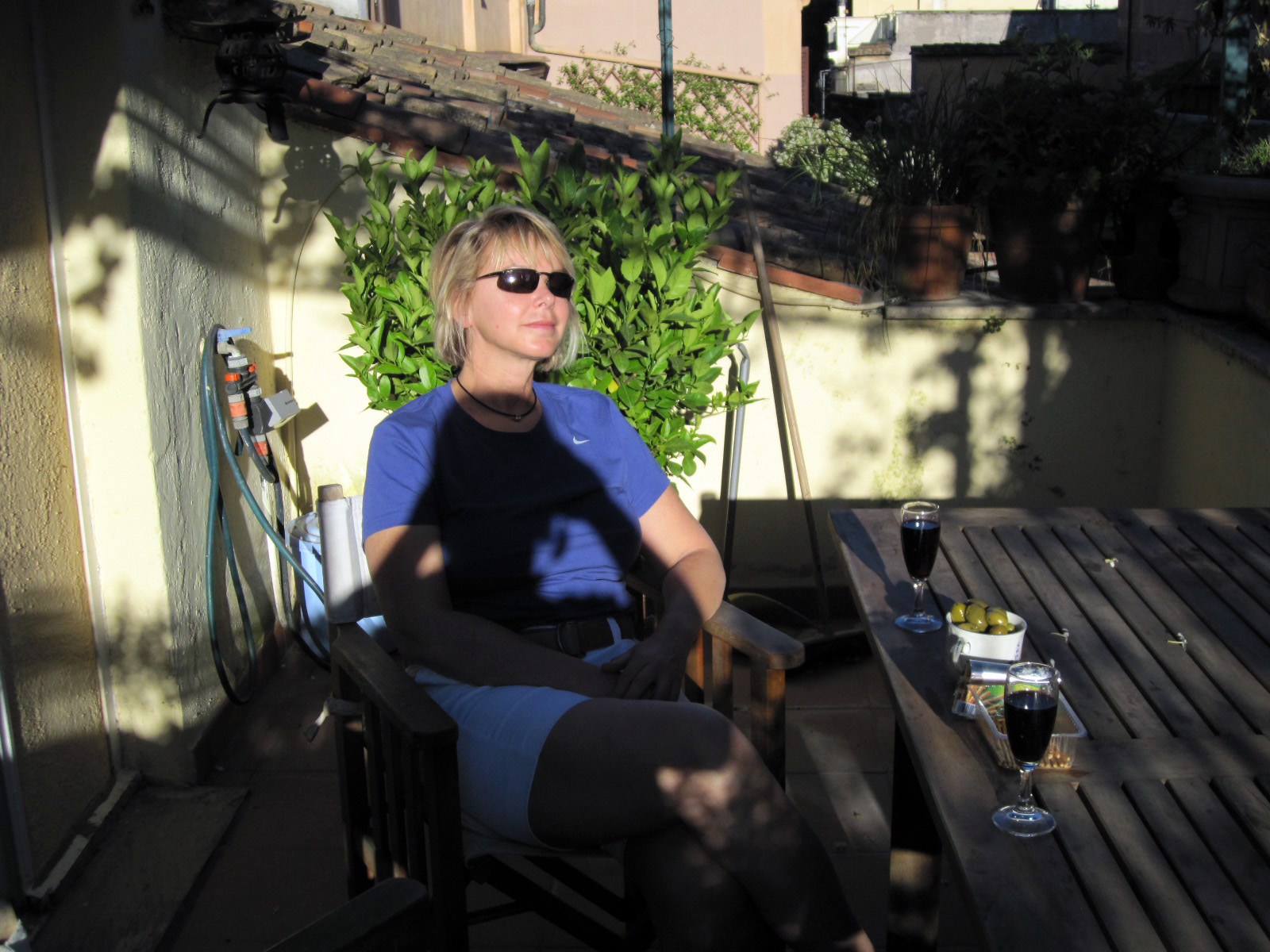 We’ve rented an apartment on the Via dei Gubbonari, a couple of short blocks from the Campo dei Fiori. It’s in a great location and there is a small terrace.
We’ve rented an apartment on the Via dei Gubbonari, a couple of short blocks from the Campo dei Fiori. It’s in a great location and there is a small terrace.
This area was once the 14th century home of Rome’s merchant district and the streets still bear the names; Giubbonari are the tailors, Cappellari are the hat makers, Chiavari are key makers. These days though, the names are more symbolic than anything else. In fact, today we found a great hat shop on Via Chiavari, the street of the key makers.
Campo dei Fiori might have started out as a morning flower market in the mid 1800’s, but it’s grown over the years into an all day open-air Mercato selling fruit and vegetables, dried pasta, t-shirts, hardware supplies, hats, scarves and whatever else they can find to throw into for fun.
The fun starts about 6am, which by the way coincides with the first wave of the squawking seagull’s dive bombing the market square in search of breakfast scraps. It’s our 6am wake-up GULLarm. Luckily we fall back asleep pretty fast.
When the market shuts down in the late afternoon the gulls return in force, scavenging the empty crates, overripe fruits and vegetables and discarded gelato cones strewn across the Campo. There’s a short intermission while the city sanitation department hoses down the square and carts off the debris before the second act begins.
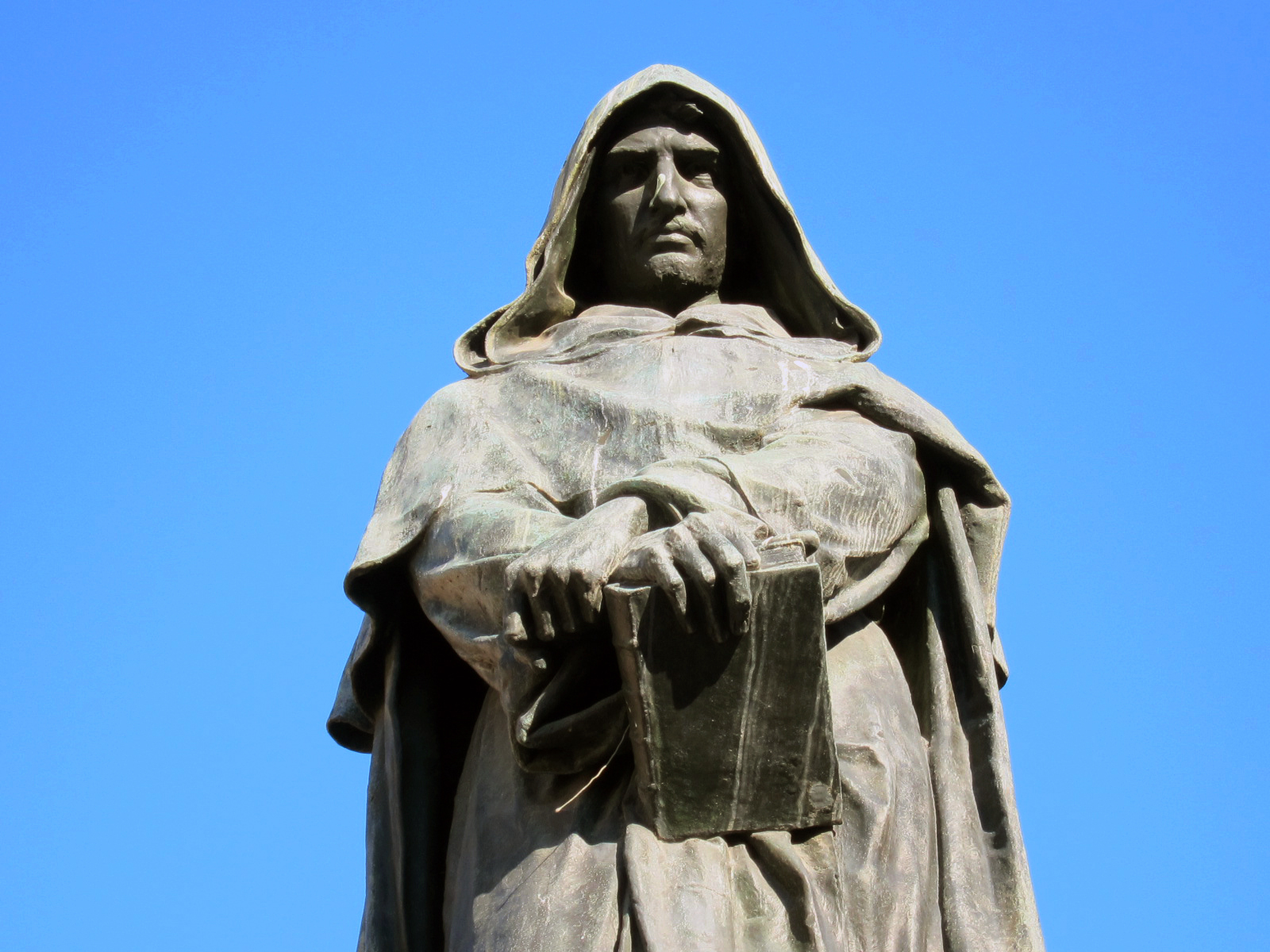 It’s the cocktail hour and cafes tables coloring the faces of the Trattorie along the Campo are filled with visitors relaxing away the late afternoon sun with a tall beer or short cocktail. The cocktail hour soon becomes the cocktail dinner as afternoon turns to evening as the guests are entertained by musicians, dancers, acrobats, street vendors, flower boys, photographers and a wild assortment of beer drinkers from every corner pub in the world, all gravitating together at the feet of the statue of Giordano Bruno, the 16th century Dominican monk scientist who was burned alive in this square for heresy during the Roman Inquisition trials of 1600s. Science and Religion have always been strange bedfellows. It was a noble gesture for the city to erect the statue, a “mea culpa” to Bruno to forgive the city for the gross injustice, but the gesture has turned into another insult as the Dominican Monk is now doomed through eternity to hold dominion over drunks and broken beer bottles. It’s a level of hell even Dante couldn’t imagine.
It’s the cocktail hour and cafes tables coloring the faces of the Trattorie along the Campo are filled with visitors relaxing away the late afternoon sun with a tall beer or short cocktail. The cocktail hour soon becomes the cocktail dinner as afternoon turns to evening as the guests are entertained by musicians, dancers, acrobats, street vendors, flower boys, photographers and a wild assortment of beer drinkers from every corner pub in the world, all gravitating together at the feet of the statue of Giordano Bruno, the 16th century Dominican monk scientist who was burned alive in this square for heresy during the Roman Inquisition trials of 1600s. Science and Religion have always been strange bedfellows. It was a noble gesture for the city to erect the statue, a “mea culpa” to Bruno to forgive the city for the gross injustice, but the gesture has turned into another insult as the Dominican Monk is now doomed through eternity to hold dominion over drunks and broken beer bottles. It’s a level of hell even Dante couldn’t imagine.
A day trip to Tivoli
Tivoli has been a summer holiday destination since the ancient Romans. While Augustus Caesar was vacationing here he sought out the advice of Albunea, the famous Tiburtine Sibyl, who (supposedly) told him of the coming of Jesus Christ. Augustus, however, was more interested to know if he would be worshipped as a god. As it all turned out, Augustus did become a god, Jesus Christ did come and the sibyl ended up on the ceiling of the Sistine Chapel in the Vatican.
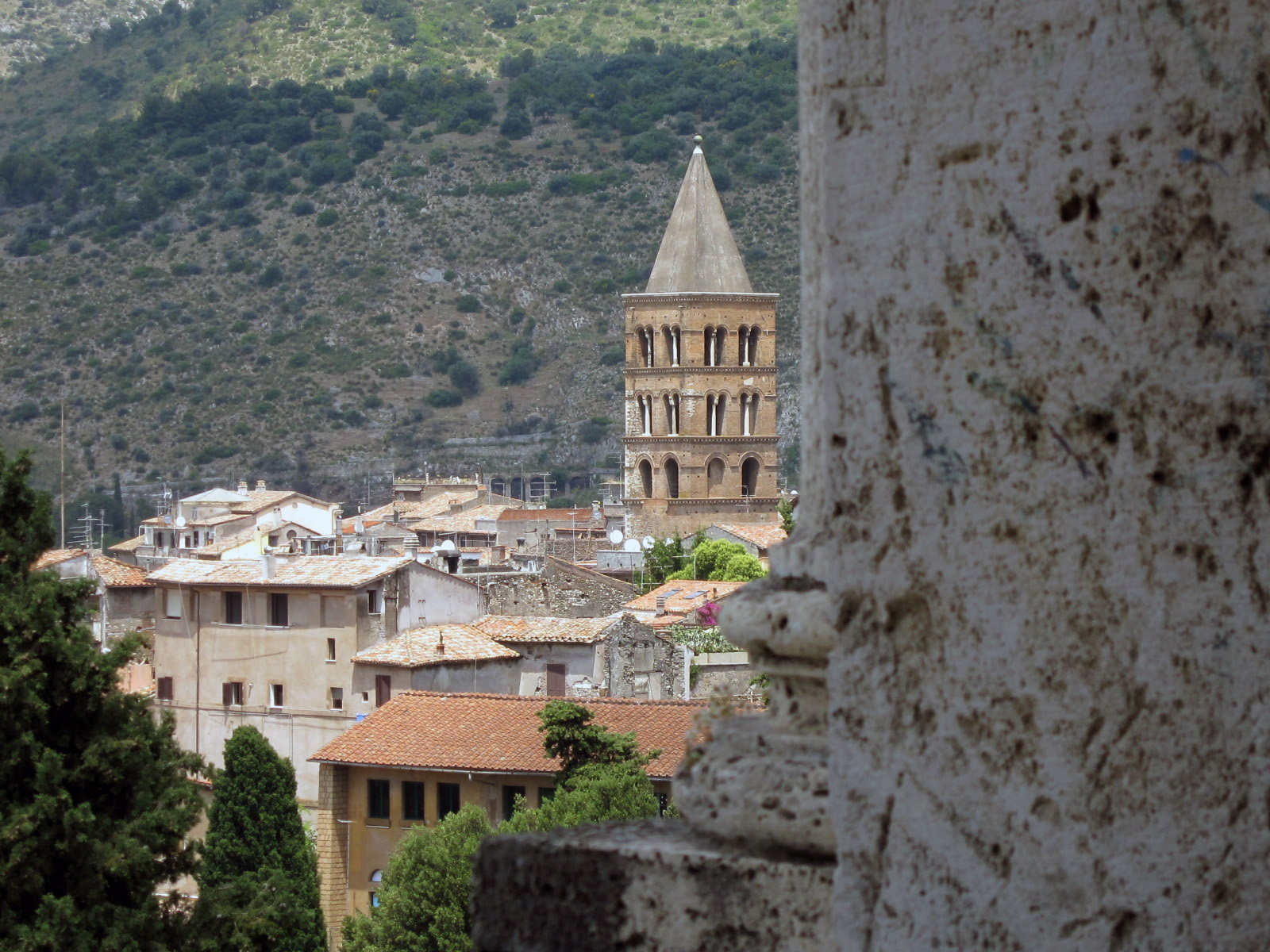 Tivoli (or Tiburi as it was known in the days of Albunea, the Sibyl) is a short 35 km from Rome; a 40 minute ride on the Metro B line to Ponte Mammolo and a transfer to the blue COTRAL bus. It’s a nice little town up in the Tiburtine Mountains, where Rome has been mining travertine stone for thousands of years.
Tivoli (or Tiburi as it was known in the days of Albunea, the Sibyl) is a short 35 km from Rome; a 40 minute ride on the Metro B line to Ponte Mammolo and a transfer to the blue COTRAL bus. It’s a nice little town up in the Tiburtine Mountains, where Rome has been mining travertine stone for thousands of years.
The two mains sites here are the 16th century Villa d’Este and the 2rd century Villa Adriana. Villa d’Este was built for Cardinal Ippolito d’Este, the son of Lucrezia Borgia and her third husband, Alfonso d’Este.
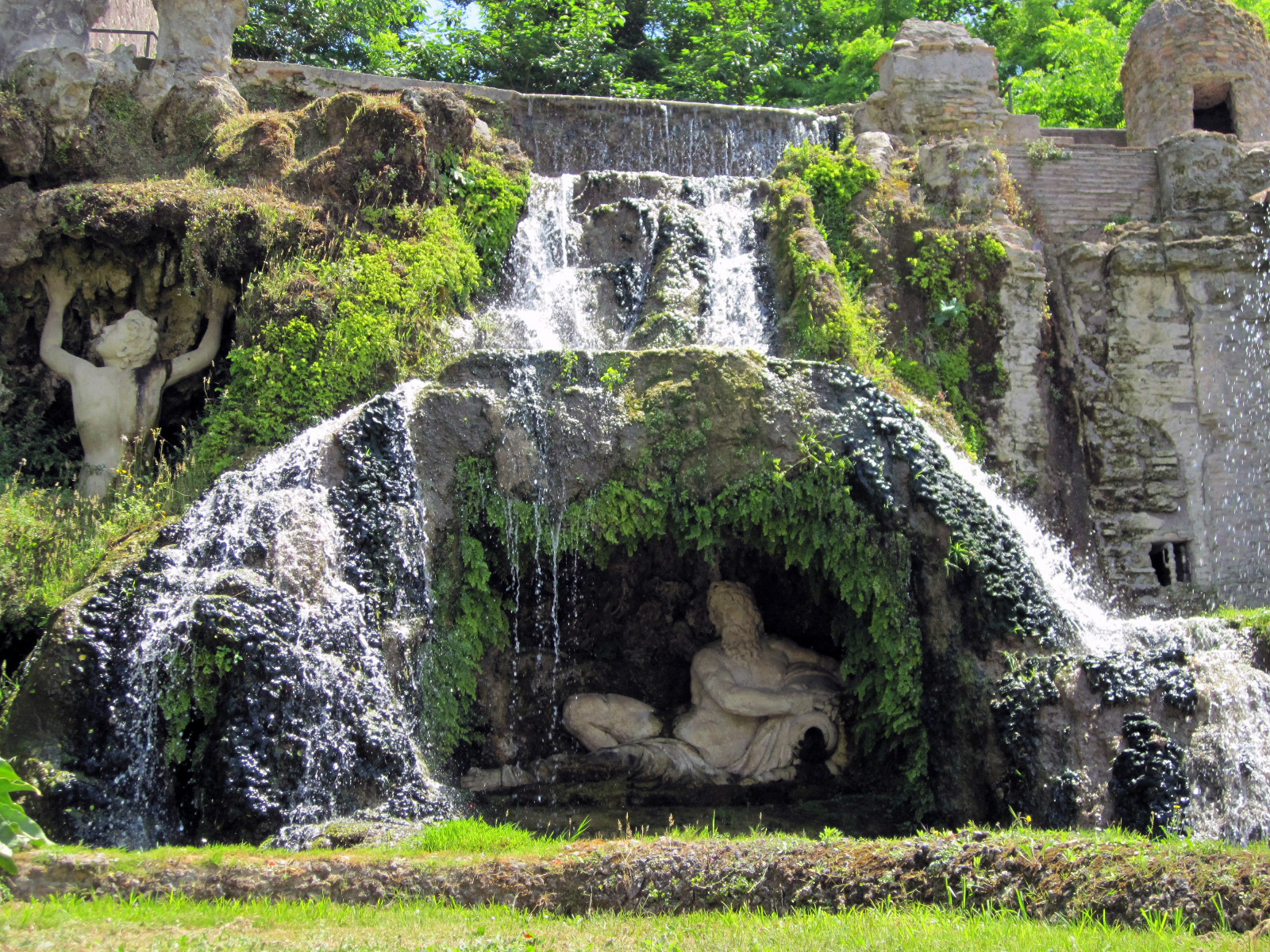 The villa, built from the white travertine of the Tiburtine mountains, has a commanding view from the top of the mountain range. The mannerist frescos of the interior are in perfect condition, as if they were recently painted, but the real treat here is the garden, or should I say gardens. Walls of sweet scented jasmine cascade down onto mythological statues, shaped hedges, fanciful fountains, grottos and waterfalls. Some of the clever water powered mechanical “toys” no longer work but on a hot summer day (like the day we were there), there is nothing like cooling off through the spray of the fountains.
The villa, built from the white travertine of the Tiburtine mountains, has a commanding view from the top of the mountain range. The mannerist frescos of the interior are in perfect condition, as if they were recently painted, but the real treat here is the garden, or should I say gardens. Walls of sweet scented jasmine cascade down onto mythological statues, shaped hedges, fanciful fountains, grottos and waterfalls. Some of the clever water powered mechanical “toys” no longer work but on a hot summer day (like the day we were there), there is nothing like cooling off through the spray of the fountains.
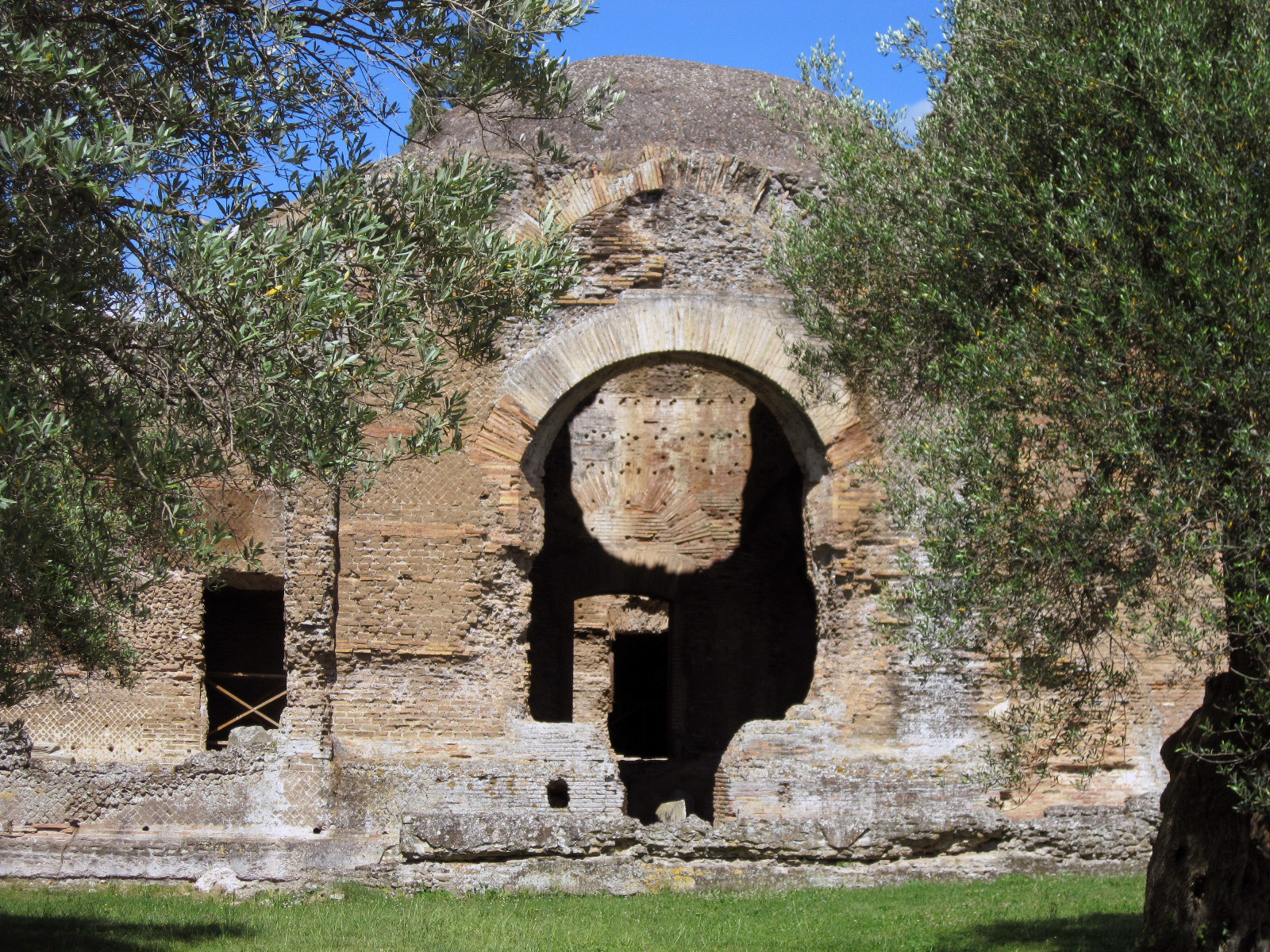 A short ride on another blue bus got us to within a 15 minute walk to Hadrian’s Villa. Some say it’s the largest Palace complex built in Italy, over 360 acres. You can still tell from the ruins how magnificent it all looked back in the 2nd century. The brick substructures of the buildings are still there but the travertine stone, marble columns and other decoration were re-issued to other villas or museums. To the new house goes the spoils. Much of the stone went into the construction of Villa d’Este. At least it stayed in Tivoli.
A short ride on another blue bus got us to within a 15 minute walk to Hadrian’s Villa. Some say it’s the largest Palace complex built in Italy, over 360 acres. You can still tell from the ruins how magnificent it all looked back in the 2nd century. The brick substructures of the buildings are still there but the travertine stone, marble columns and other decoration were re-issued to other villas or museums. To the new house goes the spoils. Much of the stone went into the construction of Villa d’Este. At least it stayed in Tivoli.
Among his credits as an Emperor, soldier, statesman, adventurer and traveler, Hadrian was an amazing architect who designed everything at the Villa, naming each location after one of his favorite travels. The large “Serapeum” dome at the Canopus pool (named for Canopus in Egypt) was one of his best designs. According the historian Cassius Dio (155AD – 229AD), Apollodorus of Damascus, the chief architect under the Emperor Trajan (Hadrian’s predecessor) was pretty outspoken of his disdain for Hadrian’s design of the Serapeum dome and wrote, “go away and draw your pumpkins, you know nothing of architecture”. Apollodorus was an architect. Hadrian was the Emperor. Hadrian and Appollodorus had a few disagreements throughout his reign. Eventually, Hadrian just exiled the old architect and then finally had him killed. There are only so many insults you can sling at the Emperor.
Hadrian went on to design the Pantheon, the Temple of Venus and Rome and a lot of other buildings in Rome. Michelangelo said he based many of his architectural concepts on the designs of Hadrian. I guess you could say he was kind of the Thomas Jefferson of the Roman Emperors.
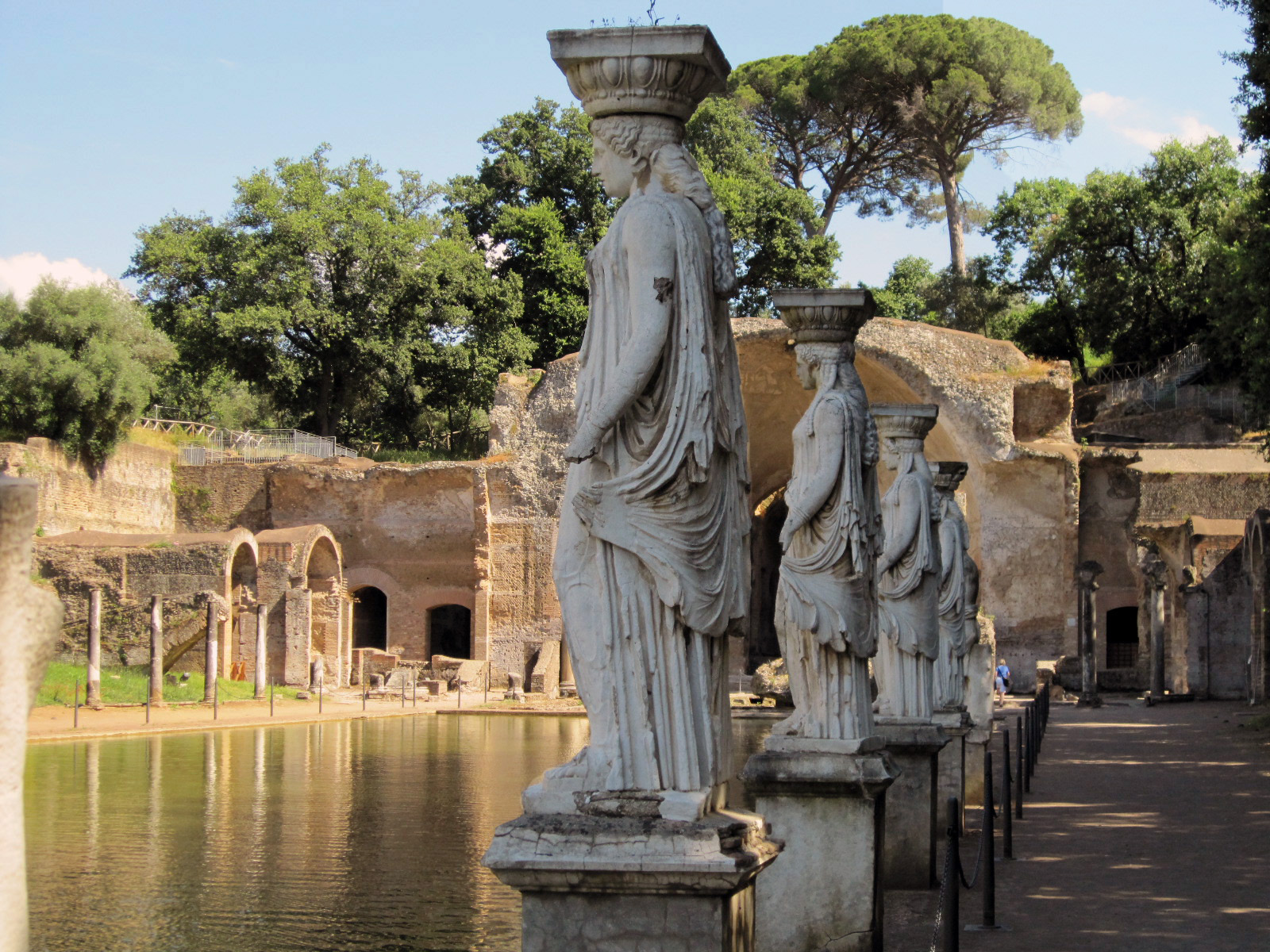 The Villa Adriana is filled with clever invention; a small island temple where Hadrian could meditate, a beach by the Canopus pool that was heated by steam pipes under the sand, libraries, theatres and lagoons. Hadrian started the Villa in 118AD, the year after he became emperor. In 128AD he moved in permanently and ruled the Roman Empire from Tivoli, thumbing his nose at the wealthy Roman patricians who never really liked him anyway.
The Villa Adriana is filled with clever invention; a small island temple where Hadrian could meditate, a beach by the Canopus pool that was heated by steam pipes under the sand, libraries, theatres and lagoons. Hadrian started the Villa in 118AD, the year after he became emperor. In 128AD he moved in permanently and ruled the Roman Empire from Tivoli, thumbing his nose at the wealthy Roman patricians who never really liked him anyway.
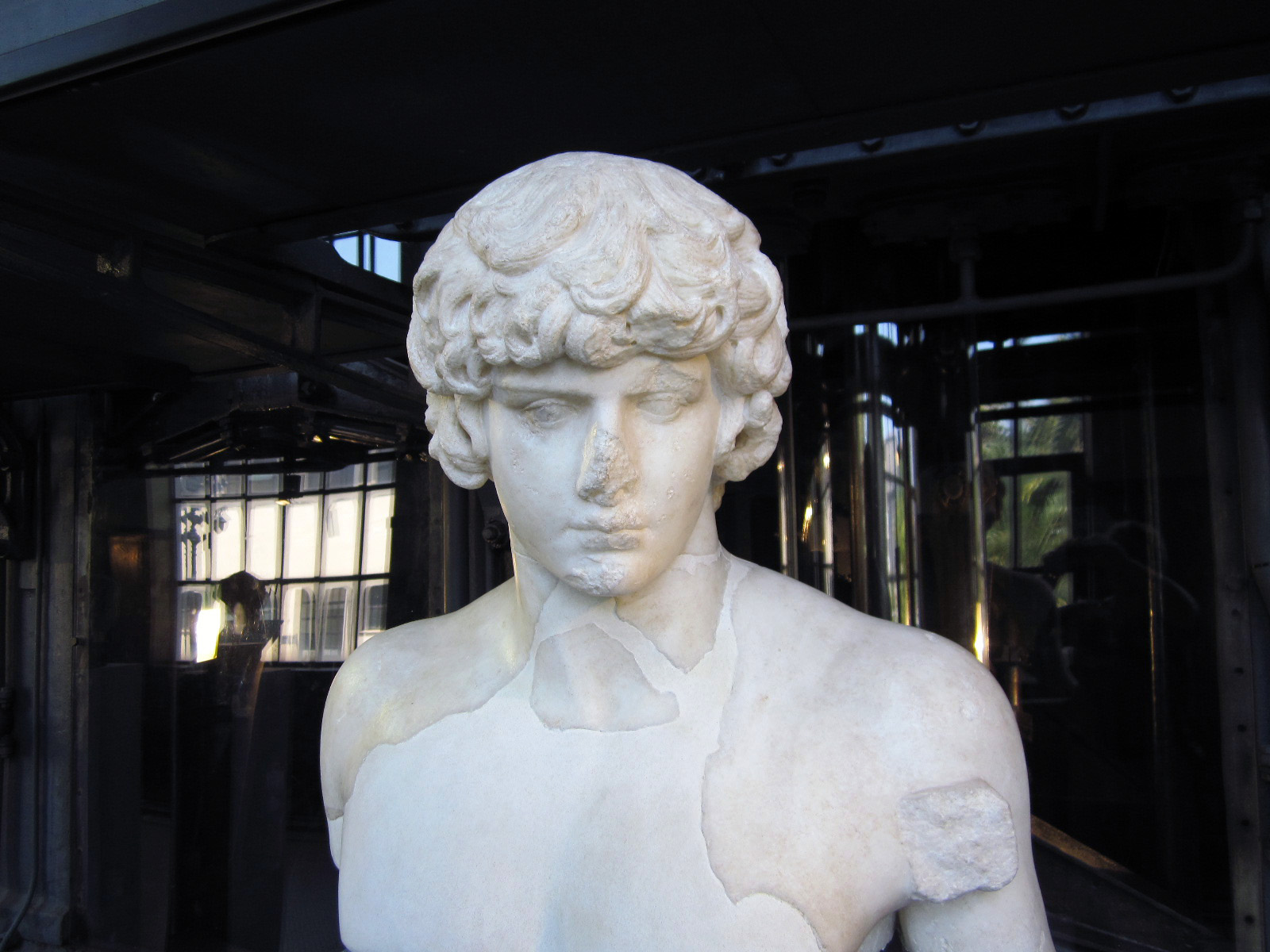 The site is still revealing more information. In 1998, archeologists uncovered what they believe to be the tomb of Antinuous, the greatest love of Hadrian. The myths of Antinuous are wonderful.
The site is still revealing more information. In 1998, archeologists uncovered what they believe to be the tomb of Antinuous, the greatest love of Hadrian. The myths of Antinuous are wonderful.
Some say he was brought to Hadrian after the emperor ordered a search for the most beautiful man in the entire Empire. Hadrian and Antinuous were happy and in love until Antinuous was killed in 130AD, drowned in the Nile. No one really knows what happened. It could have been suicide, murder or some strange religious rite. But after his death, Hadrian went to every extreme to keep the memory of Antinuous alive, including making him a god.
Renaissance Rome
Campo dei Fiori is a great spot to start a tour of some of the great Renaissance Palazzi of Rome. During the Renaissance, Rome had a population of about 60,000 people. When Michelangelo came to Rome here from Florence, he felt like he was coming to a small city. But Rome had the papacy and some very wealthy families who didn’t wish to be overshadowed by Florence.
Palazzo della Cancellaria (Chancellery near the Campo dei Fiori) was the first Renaissance palace built here, started in 1489 and finished in 1513. The massive travertine Palazzo was built from scavenging Pompey’s theatre, buried below the foundation. Pompey’s theatre once held over 27,000 people. Now it’s the underground support of all of neighborhoods around Campo dei Fiori. Some of the columns from the Pompey’s Theatre in the courtyard of the Cancellaria.
 Palazzo Farnese, right off Campo dei fiori is the largest of the private Renaissance private villas, built for Cardinal Farnese, the brother of Vannozza dei Cattanei, the mistress of Rodrigo Borgia (Pope Alexander VI), who has the dubious distinction as the most decadent Pope of all times. Vanozza was also the mother of Borgia clan; Giovanni, Gioffre, Cesare and Lucrezia. Vanozza, by the way was also the mistress of Giulio della Rovere (Pope Julius II); and while she wasn’t screwing the Popes, she managed to have 4 husbands and a gaggle of kids from other relationships. Talk a bout a full life.
Palazzo Farnese, right off Campo dei fiori is the largest of the private Renaissance private villas, built for Cardinal Farnese, the brother of Vannozza dei Cattanei, the mistress of Rodrigo Borgia (Pope Alexander VI), who has the dubious distinction as the most decadent Pope of all times. Vanozza was also the mother of Borgia clan; Giovanni, Gioffre, Cesare and Lucrezia. Vanozza, by the way was also the mistress of Giulio della Rovere (Pope Julius II); and while she wasn’t screwing the Popes, she managed to have 4 husbands and a gaggle of kids from other relationships. Talk a bout a full life.
Palazzo Farnese is enormous, over 150’ in every direction with three massive stories tall. The construction began in 1514 by the Florentine architect, Antonio da Sangallo (the younger) and taken over by Michelangelo in 1546. The last Farnese lived there till 1626.
In the early 19th century it was taken over by Napoleon and occupied by Joachim Murat, Napoleon’s ambassador to Rome who became the King of Naples. In 1871 the Italian government leased it to the French for 1 lira every 99 years. In today’s terms, that’s about ¼ of one US penny. In exchange the Italians get the same deal for the Hotel Galliffet (the current Italian Cultural Institute) on Rue du Bac in Paris. I think the French got a better deal. So do the Italians, who are still pissed off about it.
We’ve tried to get inside for years but it’s pretty difficult. However, we discovered that you can make a reservation 2 months ahead of your visit and arrange a tour, which is exactly what we’ll do on our next visit to Rome.
 A block away from Farnese is the Palazzo Spada (originally the Palazzo Capodifero).
A block away from Farnese is the Palazzo Spada (originally the Palazzo Capodifero).
The Cardinal Spada bought the Palazzo in the mid 1600’s and started an art collection that’s still there and accessible to the public. The real attraction though is the study of forced perspective by Borromini. It’s a wonderful piece and draws a lot of architecture enthusiasts like us.
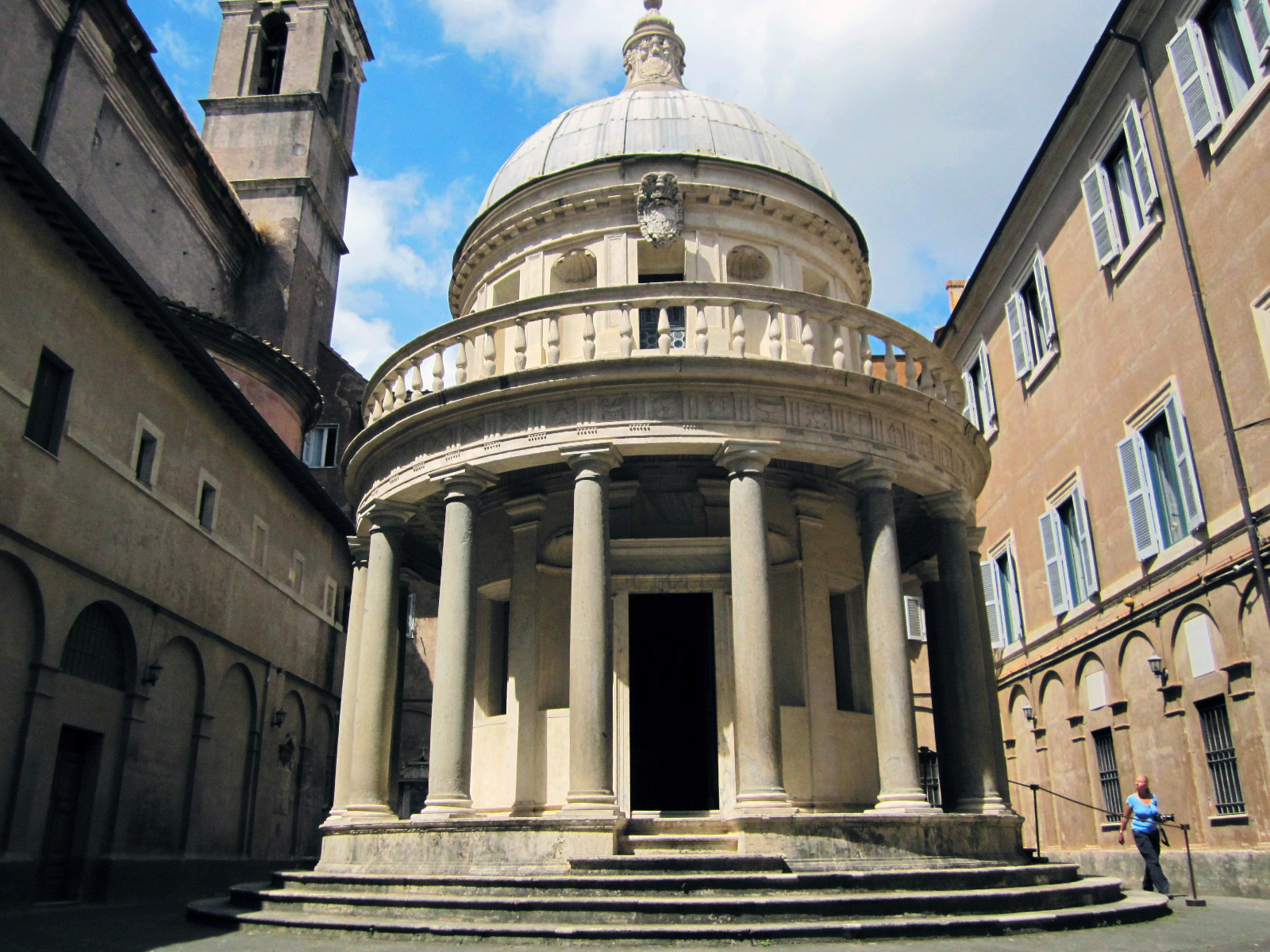 We finished out Renaissance tour in the Trastevere. We climbed the Janiculum Hill to the Chiesa di San Pietro in Montorio to see Donato Bramante’ Renaissance study of a round greek temple. Renaissance does actually mean rebirth and a lot of artists were going back to rediscover the classics to use these designs into more modern interpretations.
We finished out Renaissance tour in the Trastevere. We climbed the Janiculum Hill to the Chiesa di San Pietro in Montorio to see Donato Bramante’ Renaissance study of a round greek temple. Renaissance does actually mean rebirth and a lot of artists were going back to rediscover the classics to use these designs into more modern interpretations.
Montorio is another of the supposed site where St Peter was crucified outside of the gates of Rome and there is a wonderful carved frieze in the back of the round temple showing the crucifixion.
And we finished the day with Palazzo Farnesina in Trastevere, close to the river. In the 16th century it actually sat along the river. The Farnese family bought the Villa from the Chigi family and renamed it Farnesina. This was the country villa was Augostino Chigi, the banker of Pope Julius II. Augostino Chigi was so wealthy and so ostentatious that he was known to serve dinner on gold plates and then have his guests thrown the plates out the window into the Tiber river. The legend also says that there were nets a bit further downstream to catch the plates. He was ostentatious, but not stupid.
The Villa was designed and built between 1506-1510 by Baldasarre Peruzzi, a student of Bramante, who not only designed and built the Palazzo, he painted a good portion of the frescos himself. Raphael frescoed the “Triumph of Galatea” in the famous “throw your plates out the window” room. The frescos depicting the marriage of Cupid and Psyche in the entry portico of the Villa were done by Raphael’s students in honor of the marriage of Agostino Chigi to a much younger women. Yes, even then, wealthy old bankers were getting the beautiful young babes.
When Michaelangelo was working on the Palazzo Farnese in the city, he proposed a bridge across the Tiber to connect the Palazzo to the Villa Farnesina. It was a good idea but never built. By the way, just as a clarification, a villa is a country home outside the city walls, A Palazzo is grand home inside the city walls.
A little football
It’s pretty exciting to be in Italy during the world cup or “Mondiali” as the Italians call it. Italy’s squadra “Azzurri” won the cup in 2006 and all eyes were on them to see if they could do it again.
We watched the match of Italy vs New Zealand at “La Botticella”, a bar near Piazza Navona, owned and run by Giovanni Poggi, Rome’s biggest Pittsburgh Steeler’s fan. The bar is filled with Steeler’s paraphernalia. Giovanni was born in Rome, partially raised in Canada and somewhere along the way he dated a girl from Pittsburgh and ended up a Steelers fan. These days, he’s more famous in Pittsburgh than on Rome, and every year, he vacations in Pittsburgh where he’s treated as a King by all the Italo-Americans. During the soccer match the bar was filled with people from Pennsylvania (including Gretchen, who comes from Sharon, PA, about 60 miles from Pittsburgh). It was a lot of fun but the game ended in a tie. Italy didn’t do so well this year. The Italians say the team was too old and couldn’t keep up with the younger more aggressive players.
Rome Underground
We spent a day with a Canadian architect, Diane Archibald and two Canadian students doing their doctorate dissertations on the Goths and Longobards of Italy between the 4th and 10th centuries. We traveled through some pretty amazing underground sites looking at the development from the 1st century Rome of Augustus to the 13th century Medieval Rome. It’s all still here, you just have to find the right doors to get down there. Luckily Diane knew which door to knock on.
There are a few easy access ways of getting into Rome Underground through the Crypto Balbi on Corso Vittorio Emanuale II, near the Capitoline Hill, the San Clemente Church, close to Nero’s Domus Aurea and the Colosseo. There is also a brand new dig in the basement of the Cinema Trevi on Vicolo Del Puttarello (where they show old classic Italian films of the 60’s). It’s very near the Trevi Fountain. You’ll need your imagination to put it all together but at the Crypto Balbi (the ancient site of the Teatro Balbi) there are very good illustrations putting the site back together and showing you what it all looked like, going back to the 1st century of Augustus up through the 12th century.
The Capitoline Hill was the highest of the seven ancient hills of Rome as consequently it was the location of the Temples of Jupiter and Juno. The temple of Jupiter is now the Conservatory Museum, the Temple of Juno is now the church of Santa Maria in Aracoeli. Juno was the wife and sister of Jupiter as well as the goddess of light, the patron of finances and the deity of motherhood, which is why it was (and still is) so popular to be married in June; and we’ve seen a lot of wedding in the past couple of weeks, two of them this morning on the Capitoline Hill. I still can’t figure out how roman women walk these uneven cobblestones in those 5” spike heels. The Italians called them Tacchi a spillo (heels to a needle) and they are always in vogue. It seems that the Romans have been into fashionable footwear since the early republic. You can tell the era of the statue by the footwear and you can see the disdain for their enemies by the statues they created of them with bad footwear.
Michelangelo redesigned the Capitoline Hilltop between 1536-1546. He was in his 60’s at the time. We were told that the Holy Roman Emperor, Charles V, threatened to return to Rome in 1538 and take the city once again. In 1527, his troops sacked the city in the most brutal assault Rome had ever endured. Some of the events from the sack of 1527 are even too disgusting for me to write about. And that’s pretty horrible. Still reeling from the brutality just 10 years earlier, the Farnese Pope Paul III appeased Charles V by giving him a grand Triumphal parade ending up at the newly designed Capitoline Hill. Although the construction wasn’t completed when the Emperor arrived, he was pleased enough to leave the city in peace. Actually, Michelangelo’s Campidoglio wasn’t completed until centuries after he died.
At the center of the square is the equestrian statue of the 2nd century AD Emperor Marcus Aurelius; actually the real statue was put inside the museum in the 1980s. A copy now sits on Michelangelo’s pedestal in the Campidoglio. Over the years most of the ancient Roman bronze statues were melted down for decoration in various churches but Emperor Marcus was spared only because someone thought it was the statue of Constantine, the father of Roman Christianity. Years later, someone saw the same image on an ancient coin and realized it was Marcus Aurelius. And by that time, historical artifacts were spared.
We haven’t been inside the Capitoline museums since 1995, 15 years ago. A lot has changed. Marcus Aurelius, the she-wolf of Rome, the colossal bronze head of Constantine and a few other great pieces are now housed in a spectacular new glass covered wing. When they dug the new wing in the late 1990’s they discovered the foundation of the Temple of Jupiter Optimus Maximus. This was once the showpiece of the Capitoline and goes back to 7th century BC under the rule of King Tarquin I.
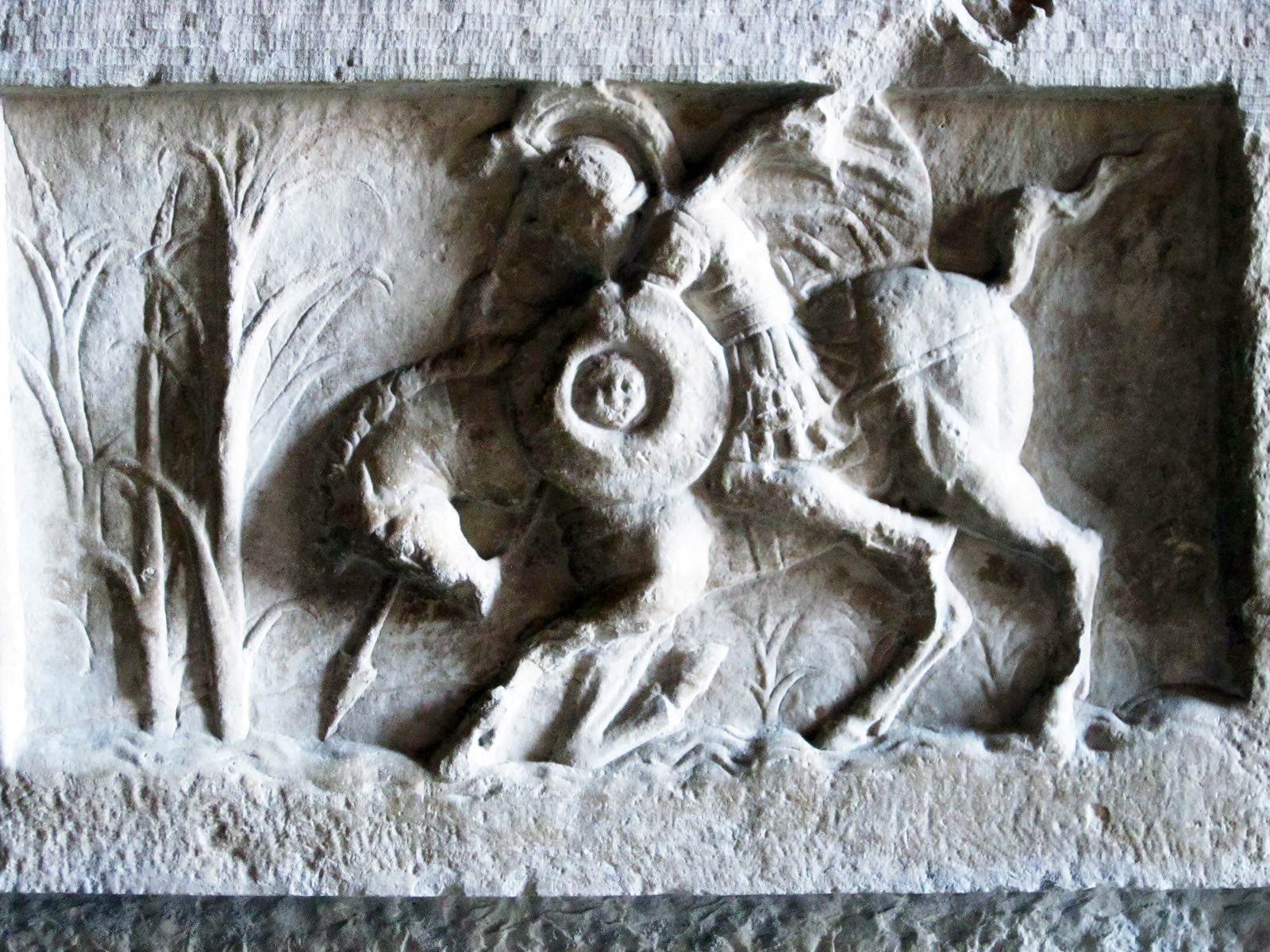 We wondered through the galleries looking at some of the most famous treasures; the Dying Gaul, the kiss of Amore and Psyche, the Capitoline Venus, the Hall of Philosophers and the Hall of Emperors; and we saw some amazing smaller pieces including an old ugly drunken woman and a carving of the legend of Marcus Curtius.
We wondered through the galleries looking at some of the most famous treasures; the Dying Gaul, the kiss of Amore and Psyche, the Capitoline Venus, the Hall of Philosophers and the Hall of Emperors; and we saw some amazing smaller pieces including an old ugly drunken woman and a carving of the legend of Marcus Curtius.
As the story goes, according to Titus Livy, in 362 BC a chasm opened up in the middle of the Forum. The people tried to fill it by throwing all kinds of things into it but it kept on getting larger instead of smaller. Finally they consulted an oracle who told them if they threw in the one thing that was most dear to them the chasm would close up. They tried throwing in their favorite clothes, their favorite votives, but nothing worked. Finally, the young brave Marcus Curtius, decideing the most precious thing was courage, fitted himself and horse in fulll armour and jumped into the chasm on horseback. The offering of his life was enough to close the chasm. The basin of the Lacus Curtius, named for the brave horseman, still exists in the Forum.
Of course, in true Roman tradition, this isn’t the only story. The origin might also be related to a Sabine soldier named Mettius Curtius who supposedly was being chased by Romulus and fell into a bog, never to be seen again. Romulus was avenging Curtius’ slaying of his general Hostus Hostilius (hey, I don’t make these names up). The basin might also be about time lighting strike that hit the forum in 445BC as witnessed by Roman Consul Gaius Curtius Philon. Take whichever explanation you’d like.
The Capitoline Museum is one of the best in the city, and one of the best museums of Roman history in the world. It is often overlooked by people who feel the “must see” tickets are at the Vatican Museums and the Gallery Borghese.
First of all, the Capitoline Museums are right there overlooking the fori. You can actually stand in the ancient Tabularium (Hall of Records) from the ancient city and look down at the Forum, over the Rostrum where Mark Antony gave his eulogy to Julius Caesar.
Inside the museum you can see the Fasti capitolini, kind of an ancient Roman calendar or diary of important events found in the Forum. The museum wanders from the ancients to the 16th century as you turn a corner or climb a flight of steps. In the Sala degli Oraci e Curiazi, a grand 16th century meeting hall there is a large canvas telling the story of the battle between the Horati triplets and the Curiati triplets. The war of power between the two families was to be settled by the Horati brothers pitted against the Curiati brothers. Two Horati were killed. All three of the Curiati were wounded. The last Horati decided to run and the as the wounded Curiati chased him they got separated. That’s when the last Horati took them on one at a time, killed them all, and became the King; in case you were interested.
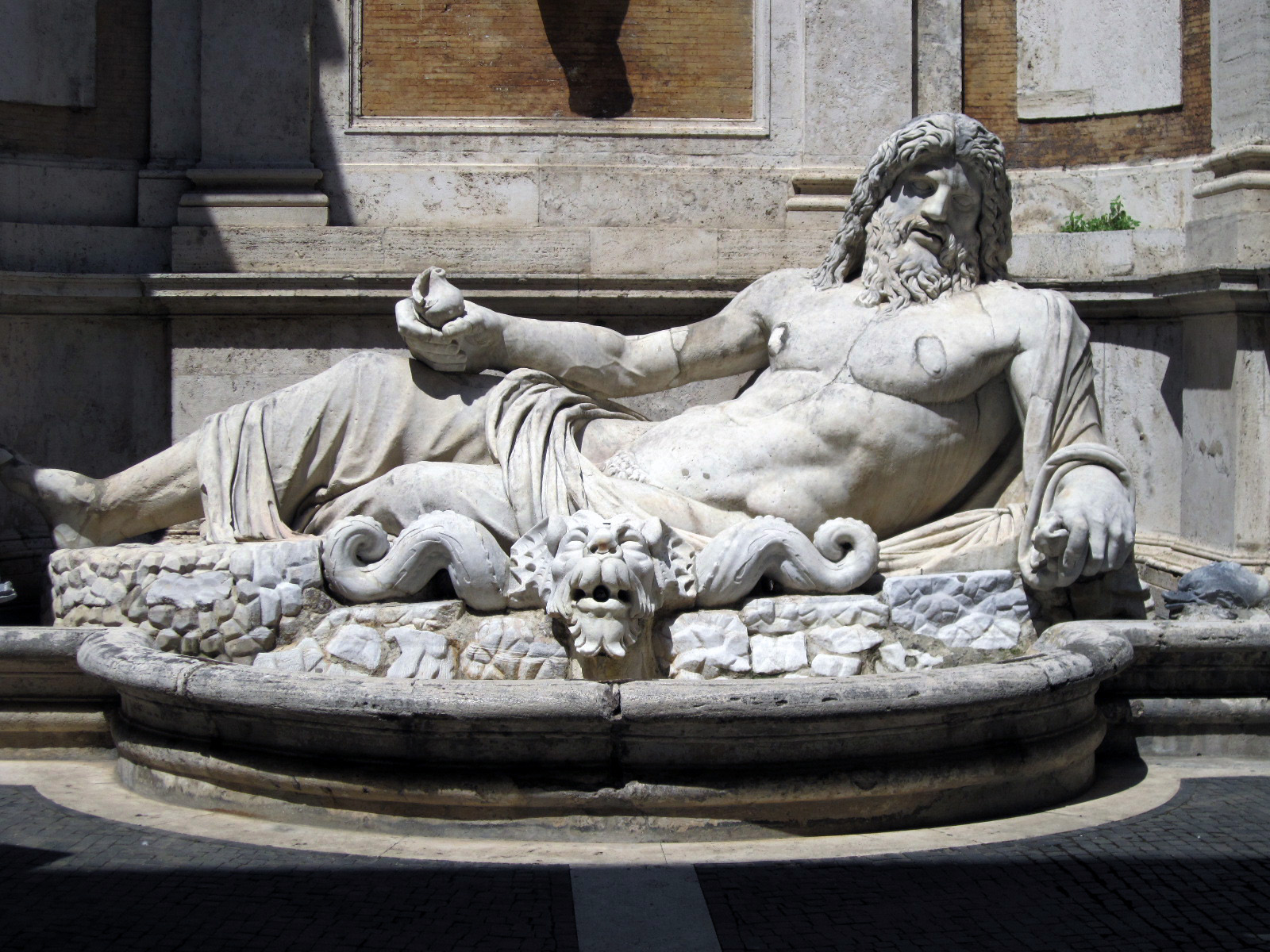 As we exited, we paid our tribute to the staue of Marforio , the reclining statue of Ocean in the courtyard of the Palazzo Nuovo. The name comes from Mare for Ocean and Forio for Forum. He was discovered in the forum.
As we exited, we paid our tribute to the staue of Marforio , the reclining statue of Ocean in the courtyard of the Palazzo Nuovo. The name comes from Mare for Ocean and Forio for Forum. He was discovered in the forum.
Michelangelo put the big guy in the Campidoglio square but he was moved years later into an alcove. He’s one of the six talking statutes of Rome, (along with Pasquino, Abbate Luigi, Madam Lucrezia, the Fontana del Babuino and the Fontana del Facchino). They’re usually covered with political protests. They’ve been shouting insults at the ruling parties since the middle ages, but for some reason, on this trip they’ve been cleaned up. All the posted notes are gone. We can’t figure out if it’s just time for a cleaning or if the government is cracking down on their critics.
I did just find out there is a new war against graffiti in the city. It’s sad to see all the buildings tagged with useless paint. We never liked the tagged buildings but always accepted it of accept it. This form of expression goes back to the ancient city. Now there is a civil force at work to clean up the city. A university law Professor named Rebecca Sptizmiller recently discovered that oven cleaner worked great in removing the graffiti from her building. She then started the organization “Retake Rome” with volunteers from all over the city. The first big event was cleaning the graffitti from the Villa Borghese gardens. Even people from the Mayor’s office showed up. There is a €1000 fine for tagging non approved buildings. However, in the true Rome tradition, there are some buildings that are still classified as OK to tag.
 Tarquinia
Tarquinia
Tarquinia is about 100 kilometers north of Rome and about a 100 minute by train.
The city was founded by Tarchon, who with his brother, Tyrrhenus, founded the twelve cities of the Etruscan empire. Tarqunia, (TarXna in Etruscan) was one of the most important city and provided two of the early Kings of Rome. After Tarquinius Superbus (Tarquin the Proud) was killed in 496 BC, the Romans had enough of absolute power and the moved into the years of the Republic.
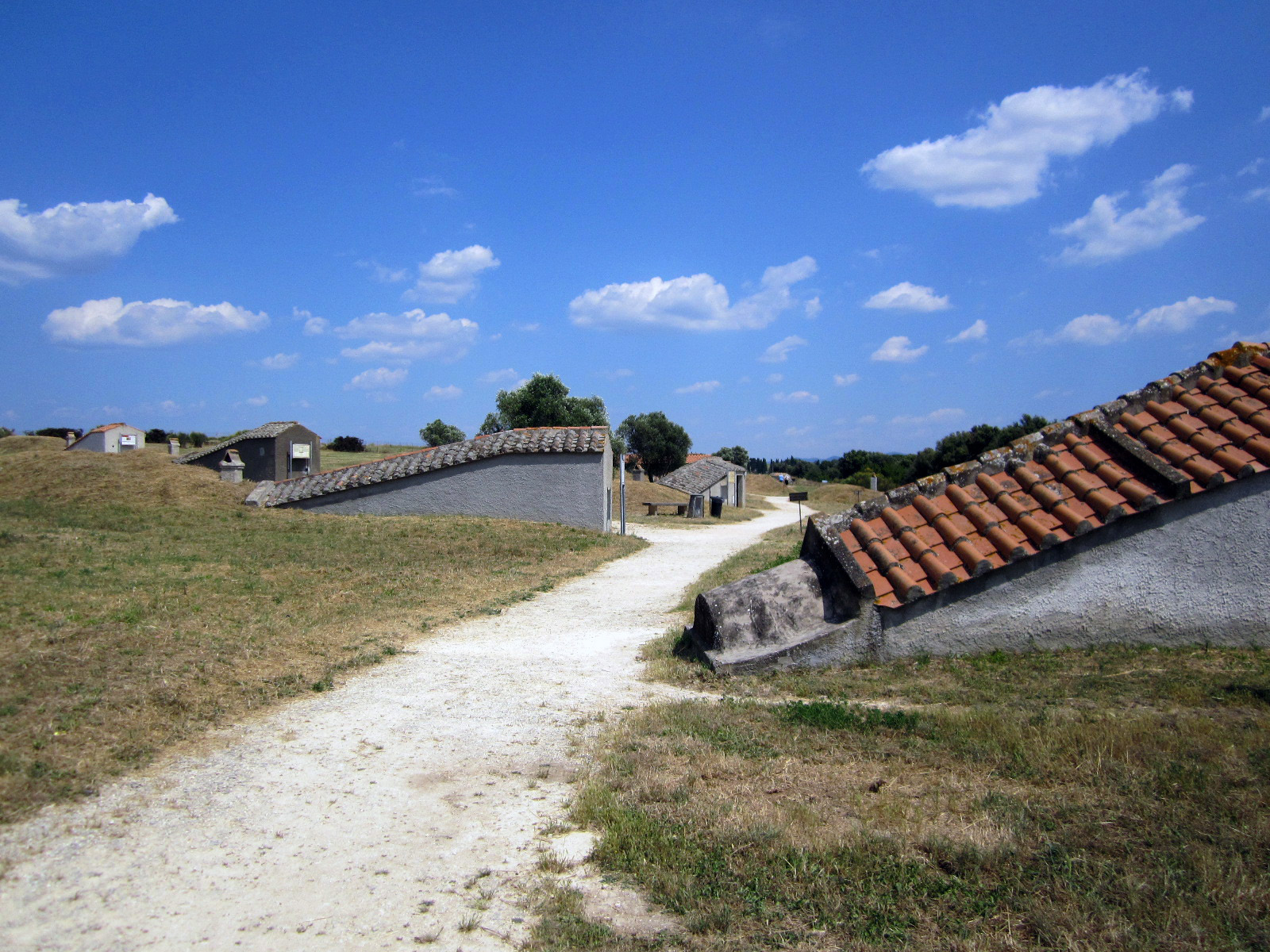 Although this is a wonderfully preserved medieval town from the 12th – 15th centuries, we came for the Etruscan ruins and the famous necropolis, with tombs dating back to the 6th century BC.
Although this is a wonderfully preserved medieval town from the 12th – 15th centuries, we came for the Etruscan ruins and the famous necropolis, with tombs dating back to the 6th century BC.
There are a lot of shuttles that run from the entrance gate near Piazza Cavour to the Necropolis but none of them run on time. We waited for about 15 minutes and then decided to walk the 2 kilometers. It turned out to be a very easy 20 minute walk.
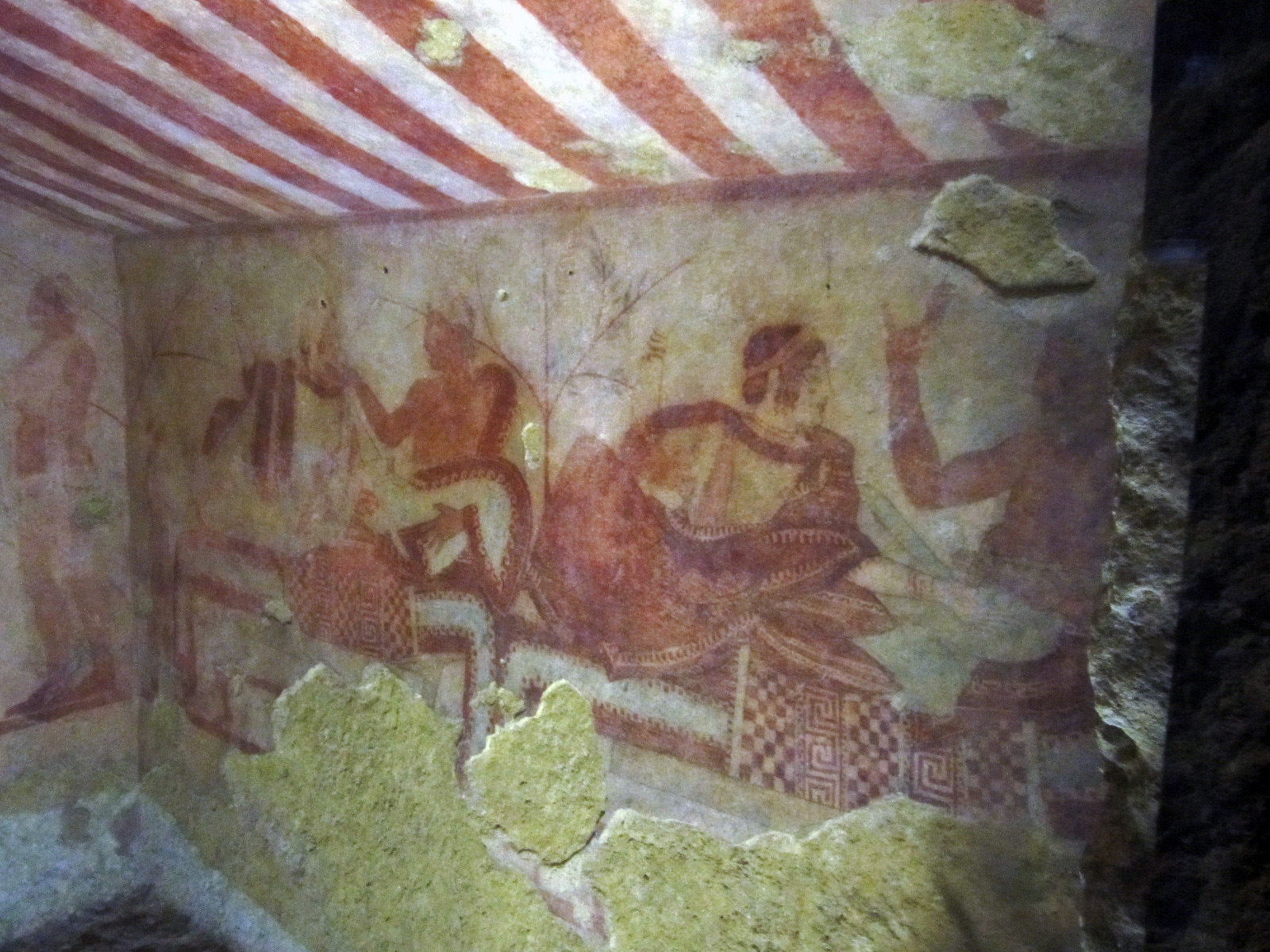 The Etruscan tombs were a lot more than we expected, kind of a mix of Greek and Egyptian tombs; rectangular rooms sealed in stone with expressive paintings depicting the funeral celebrations and activities in their afterlives. The ceiling frescoes include geometric patterns of squares or stripes. The walls are covered with stories ranging from fishing trips to erotic porn; everything they would want in their afterlife.
The Etruscan tombs were a lot more than we expected, kind of a mix of Greek and Egyptian tombs; rectangular rooms sealed in stone with expressive paintings depicting the funeral celebrations and activities in their afterlives. The ceiling frescoes include geometric patterns of squares or stripes. The walls are covered with stories ranging from fishing trips to erotic porn; everything they would want in their afterlife.
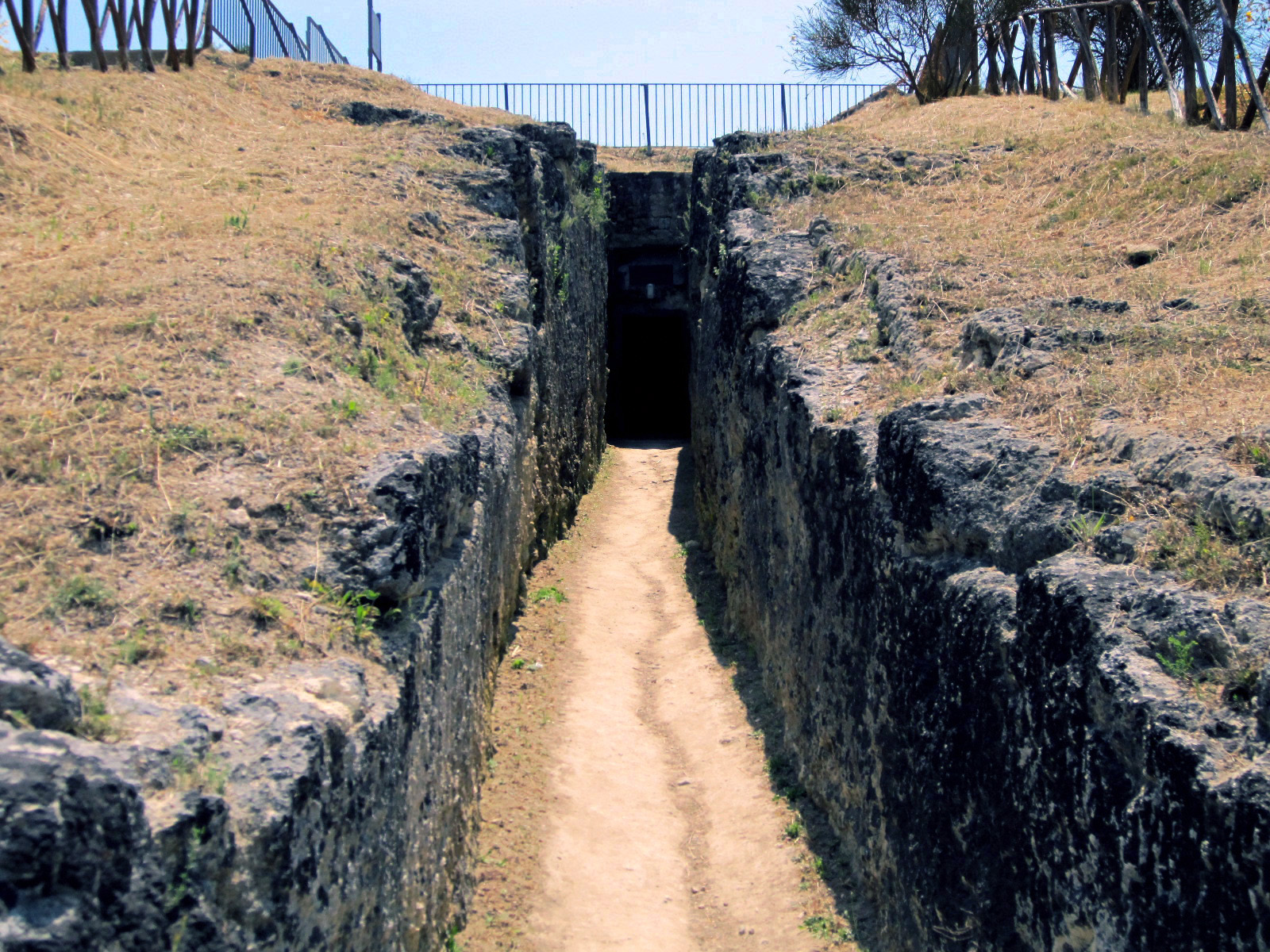 The Etruscans seemed to have a very close relationship to the Greeks, who seemed to have designed and built all of them, including the Tomba della Pulcella, with it’s long, spectacular “dromos” walkway leading up to the entrance.
The Etruscans seemed to have a very close relationship to the Greeks, who seemed to have designed and built all of them, including the Tomba della Pulcella, with it’s long, spectacular “dromos” walkway leading up to the entrance.
Supposedly, there are about 6,000 tombs in Tarquinia and over 200 wall frescos. We only visited about a dozen of them.
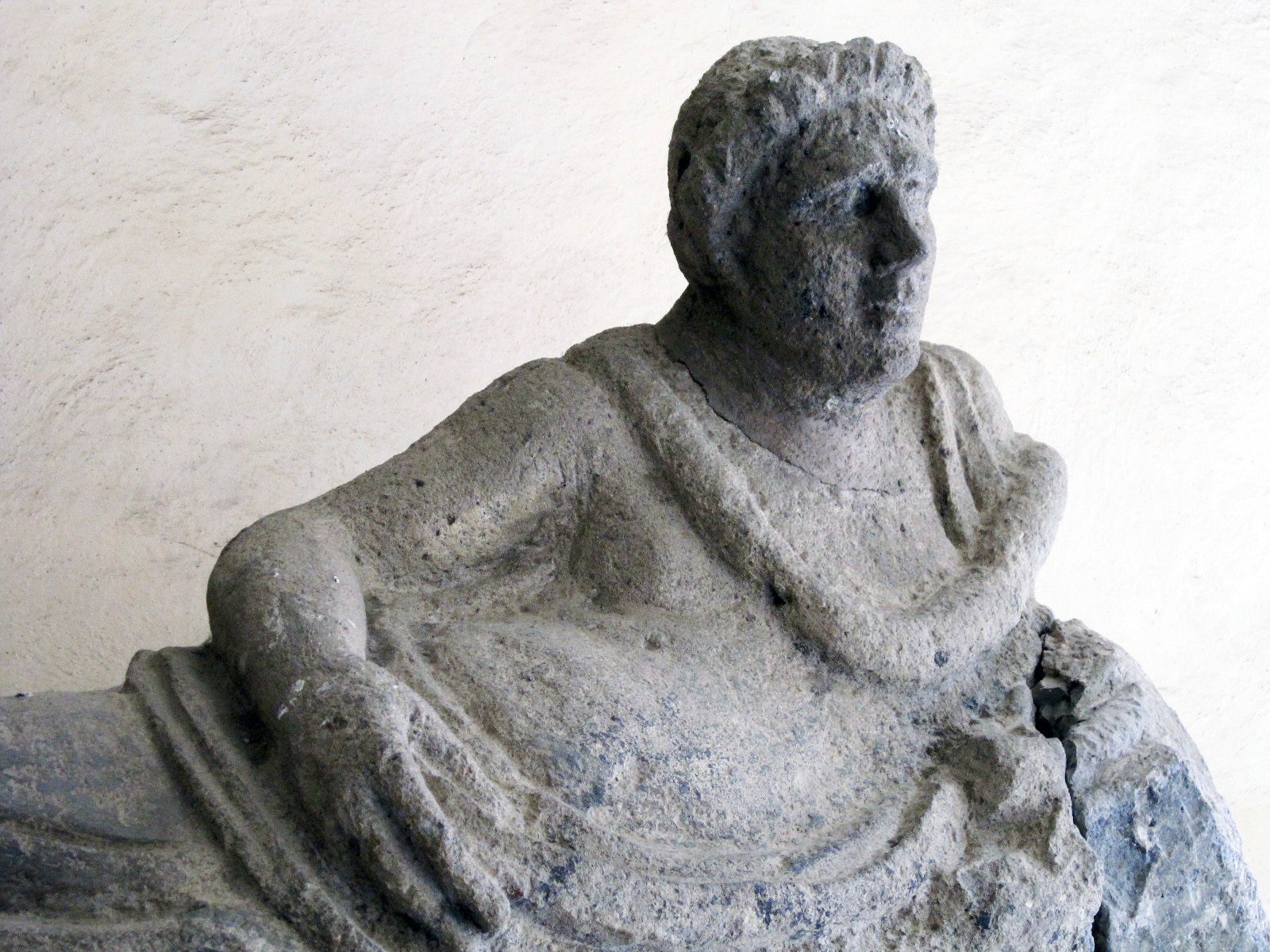 Most of the very valuable pieces (that weren’t stolen by grave robbers) were moved over to the 15th century Palazzo Vitelleschi (now the National Archeology Museum) in Piazza Cavour, very close to the shuttle bus back to the train station. The museum has everything from sarcaphogi and burial urns, to armour, jewelry, coins, candelabra and the famous terracotta winged horses from the Queen’s Ara Reginale Temple. There are even a few of the tombs reassembled into climate controlled viewing room, for those who couldn’t take the 20 minute over to the real necropolis.
Most of the very valuable pieces (that weren’t stolen by grave robbers) were moved over to the 15th century Palazzo Vitelleschi (now the National Archeology Museum) in Piazza Cavour, very close to the shuttle bus back to the train station. The museum has everything from sarcaphogi and burial urns, to armour, jewelry, coins, candelabra and the famous terracotta winged horses from the Queen’s Ara Reginale Temple. There are even a few of the tombs reassembled into climate controlled viewing room, for those who couldn’t take the 20 minute over to the real necropolis.
There is a wonderful secret stash of great statuary that was brought to the former Acea power station on the Via Ostiense. It’s walking distance from the Porta San Polo and the Piramide of Cestius (a 1st century BC burial tomb of Gaius Cestius Epulo, a very wealthy magistrate). Just take the blue line to the Piramide metro stop and walk about 10 minutes down via Ostiense.
The Centrale Montemartini was the power-station between the 1890s and 1930s. The steam engines were designed and fabricated by Franco Tosi. After Tosi was killed by one of his employees in 1898, the company went on to build the diesel engines still here. In fact, the diesel fumes are still pretty prominent.
The engines alone are well worth the trip, but when you get a chance to see amazing stautuary from the 3rd century BC up to the 4th century AD exhibited in front of the massive energy engines, it’s close to a perfect visit.
There is a story that when Mussolini ordered the forum to be torn up in order to build the triumphal Via Fori Imperiale from Piazza Venizia to the Colosseum, his team of archeologist removed so many artifacts from the dig, they had to put them somewhere and many ended up here at the Centrale Montemartini power station. However, most of this collection of ancient statues, tombs, busts and mosiacs from all over Rome moved here during the reorganization of the Capitoline Museums in 1997.
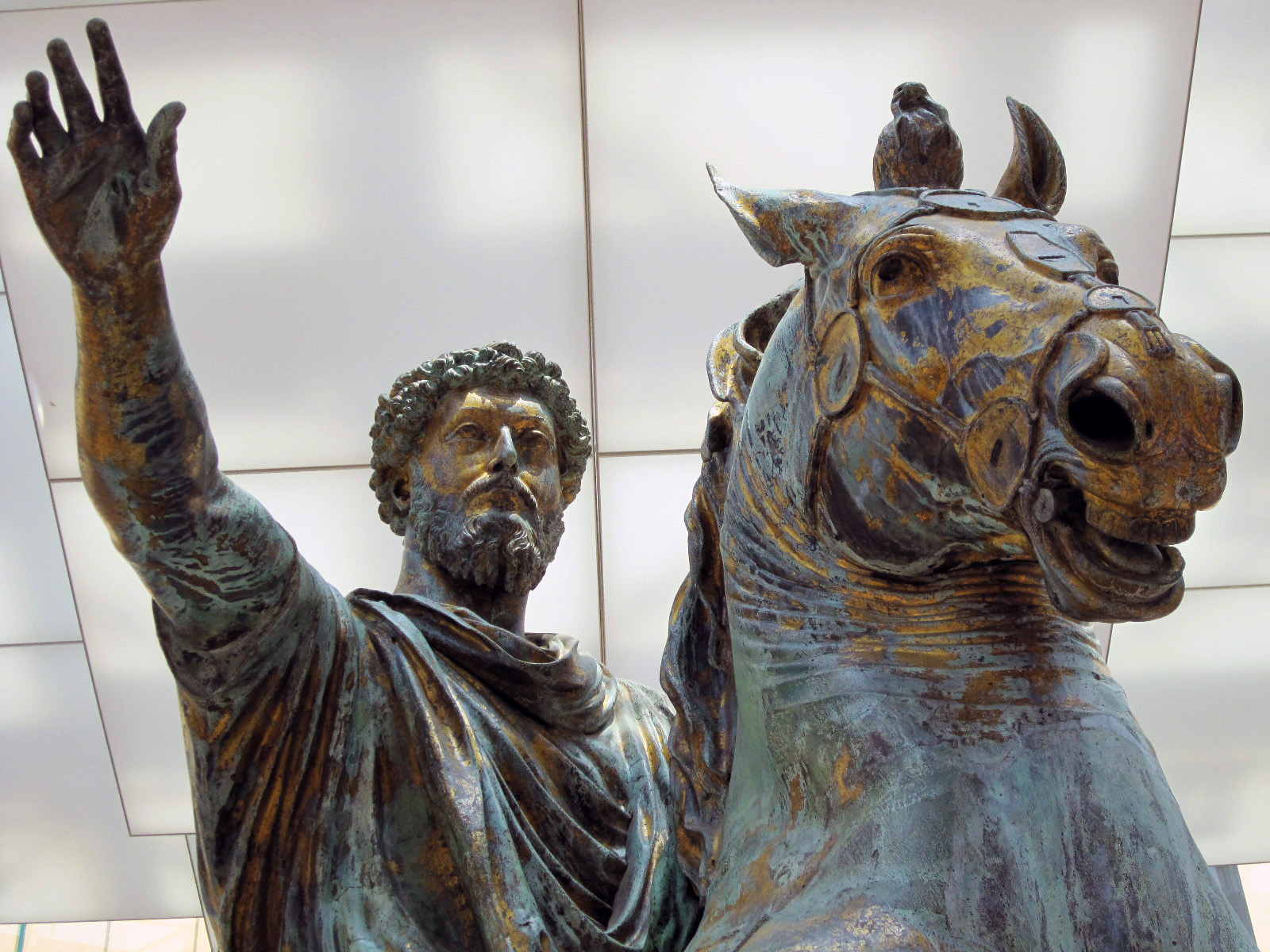
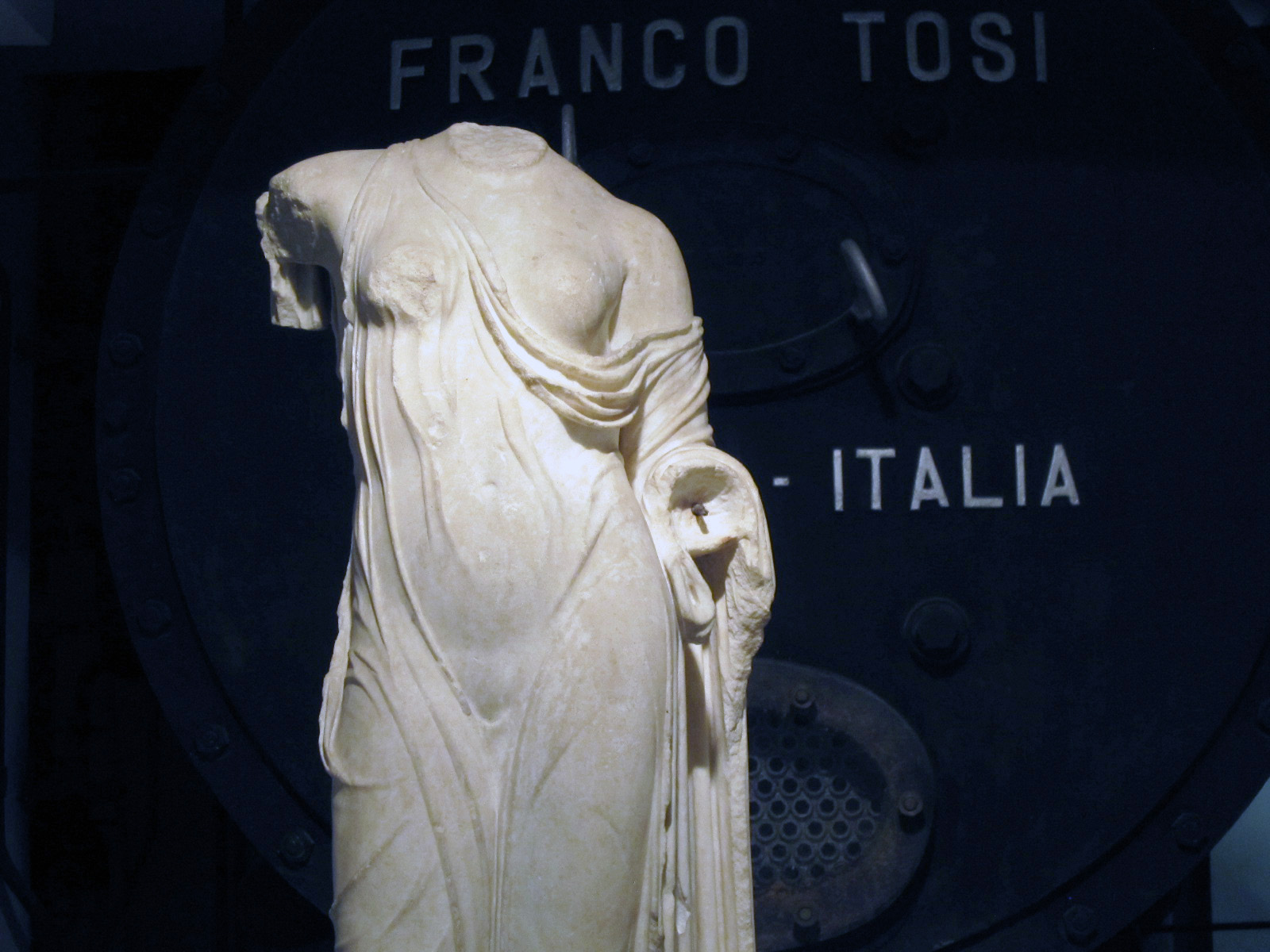
You must be logged in to post a comment.